Twenty million years ago, give a day or two, the lower lying areas just south of modern-day Melbourne, Australia, were submerged beneath a few hundred feet of seawater. When the ocean eventually receded, it left a roughly 210-square-kilometre corridor covered in a sandy loam—as deep as 80 metres in spots.
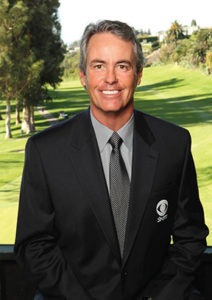
Baker-Finch has been an analyst for CBS Golf since 2007.
This geological event is clear proof that long before the evolution of mankind commenced, the Good Lord was already considering the evolution of golf, for there may not be a more perfect recipe of soil and terrain for course design than this unique Sandbelt region of Australia. Or, as Gary Player sums it up, “The greatest golf courses in one spot on the entire planet.”
I got the chance to speak to another esteemed Aussie, Ian Baker-Finch, about this grand strand of sand last Friday, a few days before he flew down to Augusta for CBS coverage of the Masters. With Australia welcoming back visitors after its lengthy pandemic slumber, Baker-Finch had been made available to talk golf on behalf of Visit Melbourne and Visit Victoria. The country is officially open to vaccinated tourists without quarantine. And while proof of a pre-departure negative Covid test is temporarily a prerequisite, as of April 17 it will no longer be required for vaccinated travellers. (Entry is still restricted, though, for unvaccinated visitors with only a few exemptions, and quarantining is still required for those individuals.)
Before his TV commentating days, Baker-Finch, who looked unfairly good for 61 years of age during our online interview, amassed 17 professional wins, the highlight being the 1991 Open Championship at Royal Birkdale. Although he was born in Nambour on the Sunshine Coast of eastern Australia, a little under 1,900 kms from Melbourne, his wife Jennie hails from Melbourne, and the couple lived there early in Ian’s early golfing career. But as a young golf pro, truth be told, Baker-Finch fell in love with the Sandbelt before he fell in love with Jennie. And while the Palm Beach Gardens, Florida, resident has called the U.S. home for close to 30 years now, Baker-Finch remains an honourary member of the famed Kingston Heath Golf Club, and is very much looking forward to returning to his native land this October to visit family and friends for the first time since Covid shut down tourism there in January 2020.
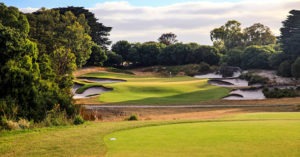
Royal Melbourne’s West Course is ranked No. 1 in Australia and No. 5 in the world.
GOD’S (AND ALISTER’S) COUNTRY
For the uninitiated, the state of Victoria occupies the southeast corner of Australia, with its capital, Melbourne, hugging the south-central coast. The region boasts some seriously stunning landscape, from the Great Ocean Road and the drama of its famous 12 Apostles (rugged rock stacks that rise up from the Southern Ocean), to the penguins of Phillip Island, to the tall forests of the 28 km-long Black Spur Drive. Or you could simply spend a week and never leave Melbourne…or get lost among the 70+ wineries of the award-winning Yarra Valley nearby. You get the picture.
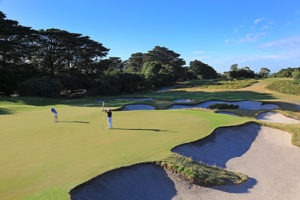
Royal Melbourne’s vaunted East Course (PhotoL Gary Lisbon)
But we’re here to talk golf, and Baker-Finch is positively bubbly about it. “I’ll be spending a full month down in Victoria (during my vacation)—probably the Mornington Peninsula and the Yarra Valley, playing some great golf,” he says.
While the region has long provided a topographical canvas worthy of a golf course masterpiece or two, it was master architect Dr. Alister MacKenzie who turned it into the Louvre. In 1926, five years before he and Bobby Jones designed Augusta National, MacKenzie paid a three-month visit to the Land Down Under to sculpt Royal Melbourne’s West course, while spreading his wisdom and architectural DNA to courses and designers throughout the land. But nowhere is the depth of standout courses more prominent than the Sandbelt, where eight world-class facilities are triumphantly woven through Melbourne’s southern suburbia. They even have their own dedicated webpage.
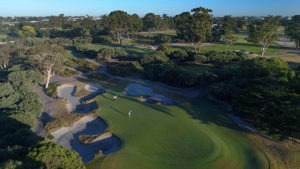
No. 10 at Kingston Heath. (Photo: Gary Lisbon)
“I still have friends who ask me, ‘Hey Finchy, where’s the Australian Open this year? Is it at Kingston Heath? Royal Melbourne? Metro? Because if it’s at one of the great courses in the Sandbelt, I’m coming,’” Baker-Finch relates. “There are layouts throughout Australia, but the Sandbelt is the best grouping of golf courses in one area anywhere in the world—and I’ve played all the great courses in the world.”
That celebration of concentration is evident in Golf Australia’s 2022 rankings of the country’s top 100 courses, with 13 of the nation’s best 20 layouts located in the state of Victoria, with a whopping seven of the top 12 situated in the Sandbelt alone. The list includes Royal Melbourne’s West Course (1), Kingston Heath (5), Peninsula Kingswoods’ North Course (6), Royal Melbourne East (7), The National GC’s Gunnamatta Course (8), Victoria GC (10), The National GC’s Moonah Course (12), St. Andrews Beach (13), Metropolitan GC (15), Peninsula Kingswood South (16), Yarra Yarra GC (17), Barron Heads GC (19) and Lonsdale Links (20).
THE LOOK OF LOVE
“The contrast you get from the perfect playing surfaces and wild, untouched landscape is visually stimulating,” Melbourne native and 2019 U.S. Mid-Am Champion Lukas Michelle says of the Sandbelt courses.
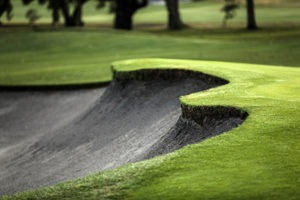
The distinctive bunker lips of the Sandbelt (Commonwealth GC). (Photo: Jacob Sjöman)
“It’s the best style of golf,” Baker-Finch echoes. “I’m a hybrid, having spent half my life in the U.S., and so is the Sandbelt. It’s part links, but with great firm and fast bentgrass greens. The Sandbelt was blessed with idyllic conditions for building golf courses. It’s not all sand, like Florida, where the bunker edges crumble in. The top layer is more like clay, very firm—a great base on which to build a golf course. Then underneath is where all the sand is, providing the natural base of the bunkers.”
The resulting bunkering appears so precisely defined that you’d swear you could shave with its edges.
But Mother Nature shares in the design accolades. “The courses are picturesque, yet rugged,” Baker-Finch describes. “They’re inviting from the tee, yet hazardous if you’re having a tough day with the driver. I love the firm and fast greens, and the roughs are like a walk in a nature preserve. There’s the smell of the natural flowers. Obviously some places have kangaroos, but the birdlife is fantastic—lots of parrots, lorikeets, Mountain Bluebirds…
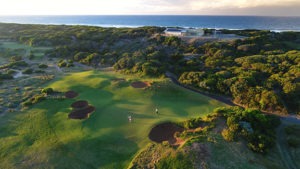
No. 7 at 13th Beach GC on the Bellarine Peninsula. (Photo: Gary Lisbon)
“I visualize playing at Kingston Heath—I’ve been a member there for 35 years and the golf is second to none,” he continues. “I kind of like January-March (as my favourite time to play), when the flowering gum trees are in full bloom. And you might get 10 or 12 different colours at different courses. Kingston Heath for example has at least 10 different varietals, including the eucalyptus.”
And what should amateurs expect, beyond those bump-and-run conditions and few fringes along the greens? “In general, you don’t lose a lot of balls,” Baker-Finch says. “There’s not water everywhere like you see here in the States. It’s natural. It’s rolling. You’ll typically hit the ball a long way, especially November through April. The bunkers are perfect. They’re visually demanding, but look worse than they really are. But it’s hard to avoid them since the greens are so firm and fast. And the best par-3s in the world are in the Melbourne Sandbelt. I could name 20 holes that could be ranked in the top five.”
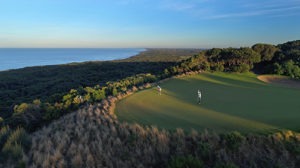
No. 7 at The National GC in Cape Schanck. (Photo: Gary Lisbon)
And the weather? “You might have a storm blow in from the south and it get a bit chilly,” Baker-Finch says. “You might have a desert wind, hot and dry, and a few flies. But, in general, the weather is so, so good.”
WORD ASSOCIATION
What’s the first thing that comes to mind when Baker-Finch hears the names of the Sandbelt’s big eight?
Royal Melbourne? “It can be rated the No. 1 course in the world of golf. It’s where the Presidents Cup has been played three times. It has everything that Alister MacKenzie had to offer. It’s exquisite.”
Kingston Heath? “It’s my favourite in Australia—always has been. And many players I know rate it their favourite in the world.”
Metropolitan Golf Club? “Some of the best bunkering in the world. Memorable. Wonderful club.”
Victoria Golf Club? “Across the road from Royal Melbourne. You can see from Victoria’s 12th green across to the 18th tee at Melbourne’s East Course, 50 metres away. A couple of the best short par-4s in the world. And a great place to stay!”
Yarra Yarra Golf Club? “Tom Doak has just done a redo there. The 11th is one of the best par-3s in the world.”
Commonwealth Golf Club? “Hidden gem. A must-play if you’re in the region.”
Huntingdale Golf Club? “The Australian Masters was there for more than three decades. I won there in 1988—I’ve got my name on one of the lockers. Demanding course, quite narrow. I think it’s the newest of the Sandbelt courses. A new clubhouse. Lovely club.”
Peninsula Kingswood Country Golf Club? “Oh—36 holes of pure golf. Just magnificent. It’s been rejuvenated. It’s not old-style as much anymore—Mike Clayton and Geoff Ogilvie have done a really good (design) job there. Beautiful clubhouse. It’s a top-10 36-hole facility in the world.”
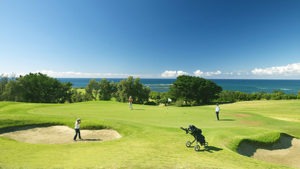
Flinders GC in the Mornington Peninsula.
While the above are private clubs, they do welcome visitors, if you go through the requisite online protocol. But be warned—they aren’t inexpensive, with $300+ green fees the norm. But there is also some great bang-for-the-buck to be had in the region. “Just an hour south of Melbourne is the Mornington Peninsula. It’s just a spectacular place to go, with about 15 courses of varying types and great beaches,” Baker-Finch notes. “You can play a place like Flinders (a club with a 119-year history, perched atop a cliff, with views to Phillip Island) for less than $50 on weekdays.”
There’s no shortage of value-priced golf elsewhere in the region either, including Port Fairy ($59-$69), a natural seaside links flowing across dramatic dunes three hours west of Melbourne.
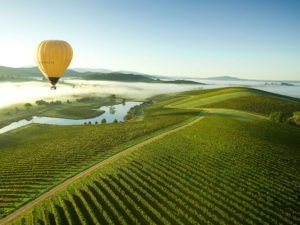
Floating over the Yarra Valley wine region.
Keep in mind that the Canadian dollars is worth a little more than the Australian dollar. And the reality is that some courses are simply worth the money. “Places like Royal Melbourne, Kingston Heath, Metropolitan, Victoria—they are a little more expensive, but you can get on them,” Baker-Finch stresses. “How many of the world’s great golf courses can you just call up and say, ‘How about Tuesday afternoon? Can I get a game?”
HEAVEN FOR NON-GOLFERS
“You can play 36 holes every day. But I think one of the great things about this region is that there’s so much else to do too,” says Baker-Finch. “There’s also the wineries, which is another passion of mine. Coldstream Hills has been one of my favourites, and it’s just an hour out of the city. And the drive from Healesville in the Yarra up into the mountains is the equal of the Great Ocean Road.
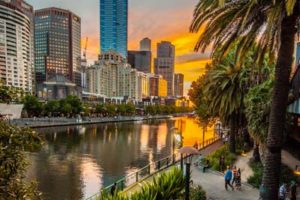
Melbourne’s Central Business District.
“Each Australian wine region is unique,” Baker-Finch says. “The Pinots in the Mornington Peninsula are as good as anywhere of the world.”
And five-star dining reigns from the wineries to the golf courses themselves, Baker-Finch notes. “And if you’re in Melbourne, well, I’ll need another half-hour to tell you about that.”
And then there’s simply the fact that you’re, well, among Australians.
“I tell my friends all the time, ‘It’s one of the great places for North American tourists to go,” Baker-Finch says. “They are always very welcomed there and it’s easy to fit in.
“But the locals will be quick to have a little fun with you—and to (poke fun) at your accent.”
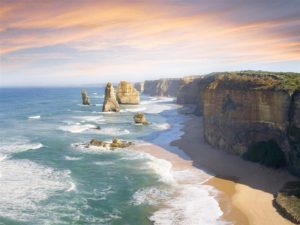

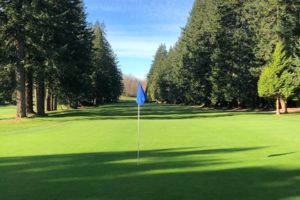
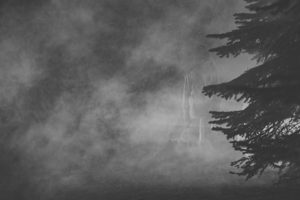
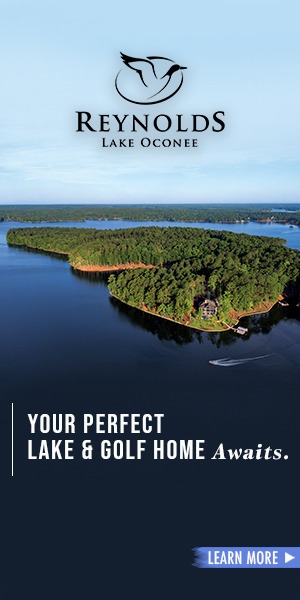

Leave a Reply
Your email is safe with us.